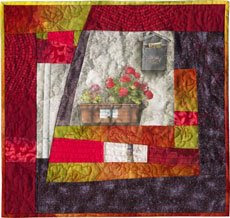 We have such a beautiful, unique, mysterious and magnificent world. Check out the aurora borealis photo to the right.
We have such a beautiful, unique, mysterious and magnificent world. Check out the aurora borealis photo to the right.What can we do to keep our world as it is or help clean up what damage we've done?
Lots of people are talking about going green. The big three auto makers are certainly taking it seriously -- their future depends on it. But what can little old subversive stitchers do to make a difference? First of all, support companies who are striving to go green. And encourage clothing and fabric manufacturers to cut waste, not just the throw aways but the toxins that wash out into our streams and lands.
Most of all -- don't let the world unravel (a creative video you gotta check out)!
Let's go green! What are some things to think about or do within the next twelve months?
- Use products made from organic fabrics and organic cotton
- Cut down or eliminate the use of plastic bags for groceries and shopping by making your own totes. Use a shee
 t! Do as is shown in the photo and make a ton of totes from one sheet. Posh Patterns by Jackie's Designs offers a free bread tote pattern.
t! Do as is shown in the photo and make a ton of totes from one sheet. Posh Patterns by Jackie's Designs offers a free bread tote pattern. - Reuse fabrics for art quilts and utility quilts or whatever you can think up. Our grandmothers did this during the Great Depression -- we can do the same thing and probably do it better. Denim jeans make great quilts for example. Or scrap memory quilts made from favorite clothing. Deb's blog gives an interesting list of denim uses from pot holders to lunch bags and beyond. I just thought about denim pockets with backing and stuffing to sit under flower pots to protect your countertops.
- Use eco-friendly batting. Maybe Dream Green, Warm and Safe eco-friendly and fire retardant,
- Join the 'Use What You Have' program and take 30 days in which you use only what is in your stash, do not buy, recycle or use the odds and ends around the house.
- Make something out of rag strips. Weave it, knit it, crochet or string piece into usable art or wall art or just something usable. Tote bags, rugs, mats, dog and cat beds, placemats, you'll think of something.
- Use leftover batting. Check out these 101 uses that include everything from dust cloths to chink in drafty windows to fill around quilts you're mailing. Or maybe splice the scraps together into a large batting.
- Maybe not exactly green, but use your fabrics to make a charity quilt for a deserving, yet needful person or animal.
- Use vegetable tanned leather rather that leather produced using the chrome tanning method
- Make your exhibits and quilt shows -- green. For example do not sell or distribute bottled water. Reduce landfill waste by thinking about every aspect of the show from handouts to food service.
- Embellish your quilts with 'found' objects -- found in nature and around the house. That orphaned button or maybe even an orphaned sock!
- Sew and quilt in the sunlight. Or if possible build your life around the sun -- when its up, so are you, when it's down -- you could head for bed and reduce electric consumption.
- Cut down or eliminate the use of chemical fabric sprays and harmful or harsh or wasteful additives.
- Use eco-friendly dyes and dye techniques -- Susan Shie advocates this in every one of her classes.
- Quilt and sew by hand instead of revving up a sewing machine.
- Make miniature quilts to use up scraps or journal or post card quilts.
- Learn to make your own starch and dyes and glues from organic and environment friendly ingredients.
- Smile more -- it will brighten you AND your environment.






